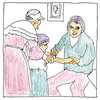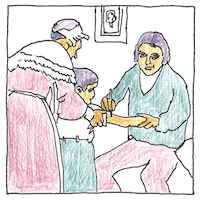Edward Jenner
immunology

|
Vaccination
The symptoms of cowpox are recoverable— a mild fever and blistering, but the symptoms of smallpox were painful and disfiguring or fatal, and if it didn’t kill, it could blind. Lady Mary Wortley Montagu, introduced in England the method of “variolation” that had been practiced in Turkey, infecting a person with the smallpox virus, variola, to induce immunity against further infection. Some still died of this cure. Meanwhile, it was commonly observed milkmaids did not get smallpox, and many people, such as Doctor Fewster, claimed an infection of cowpox prevented smallpox. The Dorset farmer Benjamin Jesty inoculated his wife and kids from an infected cow during the smallpox epidemic in seventeen seventy-four, and Edward Jenner might have known of Jesty. But Jenner was the first to show that cowpox could be exchanged by transferring the pus from a cowpox blister from human to human and the first to prove that vaccination worked— the twenty-three persons whom he inoculated with cowpox were immune to smallpox.
Eradication
Jenner’s method was quickly adopted throughout Europe and the United States. Yet in the early fifties fifty million cases of smallpox still occurred in the world each year. In 1967, the World Health Organization launched a plan to eradicate it. It was not easy; each outbreak had to be stopped from spreading. The methods were identification isolation, and inoculation. Over one hundred years after Jenner introduced his method, smallpox was eradicated throughout the world.
Terms
The smallpox virus is called variola so inoculation with smallpox was called variolation. Variola is derived from the Latin varius meaning “spotted” or varus meaning “pimple.” The Latin for “cow” is vacca, so Edward Jenner coined the term vaccination, which now refers to the method of administering an antigen to induce an immunity.



There was no treatment for smallpox. Up to 35% of people contracting smallpox died of it. During the twentieth century, smallpox killed between 300 and 500 million people, and most of these were children.
Louis Pasteur artificially weakened rabies, anthrax, and chicken cholera organisms to develop vaccines.
See also in The book of science:
Readings in wikipedia:
Other readings: